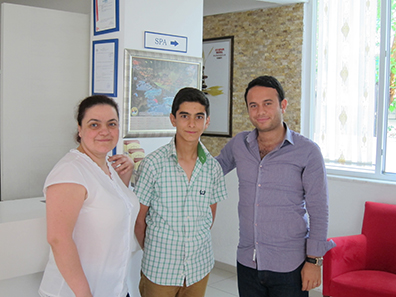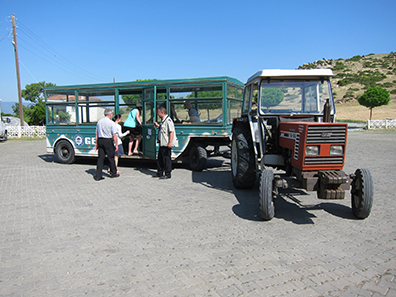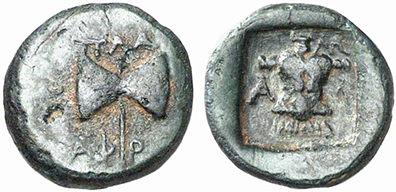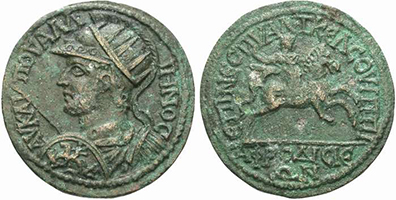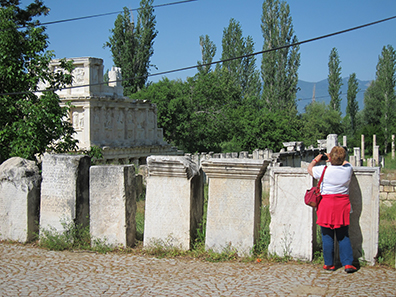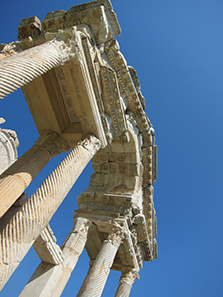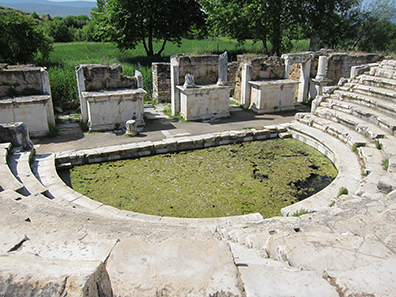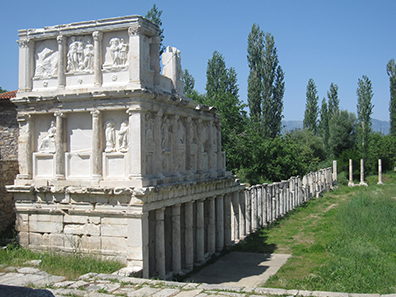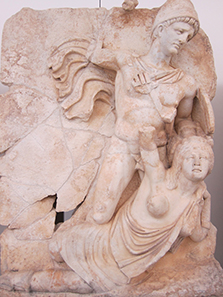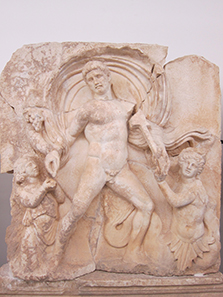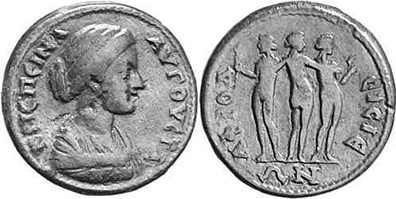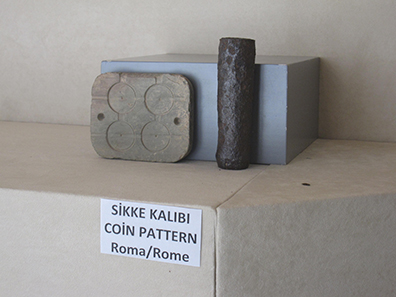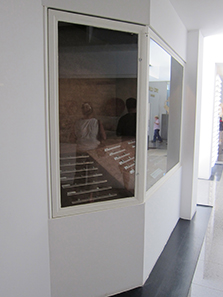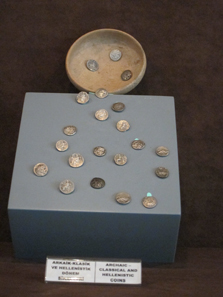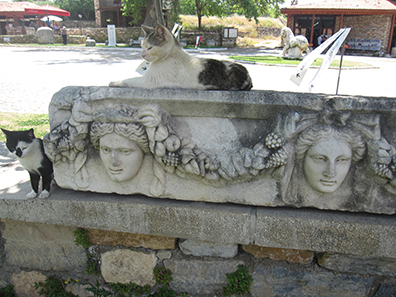by Ursula Kampmann
July 4, 2013 – Would you know what to do if your car broke down in the middle of nowhere? We learned the hard way – by doing. Join us for today’s chapter as we head to Aphrodisias, a so-called insider’s tip that in a few years could give Ephesus a run for its money.
Wednesday May 1, 2013
By this point, we’d lost our trust in being able to spontaneously find a nice little local place to stay, so this time, we booked a hotel in Hieropolis online. The pictures had inspired confidence: directly overlooking the limestone terrace, a big swimming pool and a small garden. It was a nice feeling to be able to arrive in the city late in the evening knowing where we’d be laying our weary heads. But finding the place turned out not to be so easy. Pamukkale is just a tiny place, really, with only about 2,500 residents, but the number of hotels is all the greater, considering. The hotels are no longer up top, above the hot springs, but rather below, in a sort of village. There are tons of them, and they all look the same at first glance: an L-shaped residential complex, a tiny pool, a few bushes, and a roof terrace from which, if you’re standing in the right spot, you can actually see something white off in the distance. In early May though, the terraces weren’t yet open and the swimming pools were empty, but these two minor flaws that didn’t bother us in the least.
The troops at the Ayapam-Hotel in Pamukkale. Turkish hospitality at its finest. Photo: KW.
That’s because the Ayapam, where we stayed, won us over not just through its facilities, but also because of the amazing friendliness and hospitality of the people who run it. Nihal at reception beamed whenever we came to him with a request. Hüseyin, the bellboy, charmed all the guests by loading them and their bags into the elevator only to greet them again upstairs, waiting with a smile to take the bags. Ramazan, the hotel manager, had his dinner in the dining room every night, eating the very same food that he served his guests. And I can understand why…
Turkish food at its best in the Hotel Ayapam, presented by chef Nurettin Tastan. Photo: KW.
Because the quality of the food was outstanding! Nurettin and Melita, who had started preparing the fragrant delicacies that afternoon, served the food at the buffet and gladly accepted the guests’ compliments. And who can forget Yusus, the waiter, who was pleased that we’d ordered in Turkish so that he could reply in perfect German. And all this still doesn’t even begin to adequately describe the overwhelmingly warm atmosphere at this hotel. In short, we felt very, very happy and at ease.
May 2, 2013
Early in the morning we drove to Aphrodisias, which some guidebooks still treat as an “insider’s tip.” “As for the question of whether these ruins are comparable to those of Ephesus, opinions tend to differ. A point in Aphrodisias’ favour, at any rate, is the quiet solitude it offers from tour groups,” says the online guide bacoo, just one of many publications that include Aphrodisias under the “unknown” attractions. We started doubting these statements a bit when we saw the new roads that, not that long ago, had been widened to accommodate two tour buses.
Transport from the parking lot to the excavation. Photo: UK.
Any remaining doubts vanished as signs led us to a gigantic parking lot, from which we were then driven to the excavation itself in an adorable little tractor-train. We were there early. There were only two buses in the parking lot. By the time we got back to the lot, there were about 30 buses – so although Aphrodisias may still not compare to Ephesus numbers-wise, it’s certainly a far cry from deserted.
Aphrodisias. Caligula, 37-41. Small bronze. MMDe 20 (2006), 205.
Historically speaking, Aphrodisias still lags far behind Ephesus in terms of significance. In fact, not much is known about its early history prior to the 1st century BC. Excavator Kenan T. Erim believes that there was an ancient Ishtar-Astarte cult here, which was known as Nin, Ninai, Nana or Enana. Derived from this was the city name, “Ninoe,” which was translated as “Aphrodisias” with the onset of Roman rule. Aphrodite was fashionable among the Romans – it’s not for nothing that Sulla and Caesar appealed to their good relations with the goddess of love. And in fact, Appian reports in the 2nd century AD that Sulla, in the war against Mithridates of Pontus in Asia Minor, received counsel from the Delphic Oracle to worship the Carian Aphrodite.
Aphrodisias / Plarasa. AE, 1st century BC. Lanz 131 (2006), 85.
It’s from around this time that the earliest known coins of Aphrodisias date. They don’t depict Aphrodite, however, but rather a double axe and armour. What’s more, the coins bear not only the city name of Aphrodisias, but also of Plasara, which suggests a close relationship between the two cities. But Aphrodisias’ great period began only when Octavian defeated Caesar’s murderers. Aphrodisias had been pillaged by the troops of Labienus, and now, as a reward for its resistance, received municipal liberties, fiscal autonomy and an extended law of asylum for its Aphrodite Temple. A period of prosperity made the small provincial city between Lydia and Phrygia into the magnificent urban centre whose traces we can visit today.
Frieze from the Portico of Tiberius. Photo: KW.
Pivotal to this development was also the city’s famed sculpture school. There were rich marble quarries very close by, and the raw material was used here to create these almost pre-industrial semi-finished products according to sample books.
The same woman’s head – one perfect, the other not quite. Photo: KW.
There’s a truly impressive amount of good (and not so good) sculpture on view in Aphrodisias. And, in fact, it’s only through the excavation of numerous half-finished works and test pieces that we know of this school.
Unfinished statue of an athlete in the Museum of Aphrodisias. Photo: KW.
In addition, many of the statues have the sculptors’’ signatures attached, which likely facilitated the settling of accounts after completion of a project.
Aphrodisias. Gallienus, 253-268. Rev. Emperor on horseback, facing right. MMDe 13 (2003), 405.
The decline also began in Aphrodisias in the 3rd century, although it must still have been a thriving city in Late Antiquity. It had a bishop’s see, it produced two martyrs, and was renamed as “Stauropolis” ( = city of the cross) at some point, only to be later referred to as “Caria” by its residents (During the Christian Era, Aphrodite was probably no longer a good namesake). And then Caria became Geyre, as the small town where Aphrodisias is located today is known.
Fence of inscriptions. Photo: KW.
What really strikes you in Aphrodisias is the abundance of material just lying in wait for a visit. There was already enough to build an entire fence out of inscriptions in order to prevent visitors from getting too close to the Augustus Temple.
The Tetrapylon. Photo: KW.
The so-called tetrapylon serves as the charming start of the circuit. This ornate gatehouse could be straight out of the Roman Baroque period.
Detail of the tetrapylon. Photo: KW.
Anyone who thrives on classical simplicity and size would probably avert their eyes in horror here. Nevertheless, the workmanship and artistry on display is undisputable.
Temple of Aphrodite. Photo: KW.
Lurking almost in the shadows is the still very grand and imposing Temple of Aphrodite. Its good condition is likely owing to its conversion into a Christian basilica in the 5th century.
Bouleuterion. Photo: KW.
The bouleuterion is of particular numismatic interest, …
Aphrodisias. Bronze, 3rd century AD. MMDe 21 (2007), 672.
… as the boulé is depicted on many of the city’s autonomous coins.
Agora with flooding. Photo: KW.
Apart from that, there’s also all of this on offer in Aphrodisias: Hadrian thermae, a (flooded) agora, a large theatre and many tour groups. The come from Germany, France, the USA, and, not quite as often, from Russia. But that will no doubt change – the material here is just too good not to serve as a photo backdrop.
Sebasteion. Photo: KW.
The fantastic reliefs that were revealed during the excavation of the sebasteion form the highlight of the visit. This shrine was endowed in honour of the Emperor by two different families who, during the reign of Claudius and Nero, paid out a great deal of money in order to pay homage to the Emperor with this special honour.
Claudius and Britannia. Photo: KW.
As such, there are magnificent reliefs with depictions of the Emperor – of varying quality. So, it seems the upper anatomy of Brittania was not based on nature’s template, …
Claudius as ruler over land and sea. Photo: KW.
… whereas Claudius is of a quality that would have been admired in Rome.
Aeneas flees burning Troy. Photo: KW.
It’s an inspiring picture book of known and unknown scenes from mythology. Anyone who’s ever dealt with Caesar’s denarii will be familiar with this scene.
Caesar. Denarius, 47-46. MoneyMuseum collection, formerly Wyprächtiger.
Caesar flees burning Troy, his father Anchises on his shoulders. Beside him are his wife (who he will, as a precaution, lose in Troy) and his son Julius.
The Three Graces. Photo: KW.
Not quite as well known is the numismatic afterlife of the Three Graces, …
Aphrodisias. Crispina. Bronze. Gorny & Mosch 126 (2003), 1832.
… who appear here, for example, on a coin from Aphrodisias.
Coining stamp and coin blank mould. Photo: KW.
Even though there are quite interesting numismatic finds to report here, they’re overshadowed by the incredible reliefs.
Display case with coin finds. Photo: KW.
A somewhat carelessly assembled display case stands at the edge of the stream of visitors …
“Archaic, Classical, and Hellenistic” coins. Photo: KW.
… and only a coin enthusiast would be upset by the fact that tetradrachms of the Alexander type are referred to here as “archaic, classical and Hellenistic” coins.
A little break from Antiquity. Photo: KW.
And by then, we’d had enough anyway. We had a seat in the excavation’s newly opened cafe. There was no tea or Turkish ayran to be had. And large bottles of water? Not a chance. The only large bottles of water came from a well-known source in France that shall remain unnamed, and cost a fortune by Turkish standards. We sat down anyway and watched something that we’d not seen quite like this before in Turkey: The Turkish people have an ambivalent relationship with cats and dogs. While on an earlier excursion, in the little port of Assos, there was always a full bottle of water ready to scare away cats, in Selcuk the proprietor had put the leftovers from our meal onto the curb so the small cats could eat to their heart’s content. In Aphrodisias, I watched a Turkish guide catch one dog after another to pick the ticks out of their fur. Unappealing work, to be sure, but one that the animals definitely appreciated. They literally jumped at the chance to be caught by him …
We drove on though, and not on the main street like most buses, but in the other direction, hoping to return to our hotel via two passes through the mountains instead. We were all alone on this route, and the only consolation was the many gas stations that we passed every 5 kilometers or so, even in this mountainous seclusion. This was our sole salvation too, when our engine started knocking in such a way that it seemed more than advisable to stop and pull over immediately. We made it one more gas station, and then that was it.
What does one do in such circumstances? My Turkish wouldn’t have been enough to explain to the gas station attendant that we weren’t just there for gas. Keep driving? Not a chance. Also, I had no clue where we even were. In desperation and not expecting much, I called the ADAC emergency hotline. I was connected immediately, and a young man asked me gently what had happened and where our car was. “Not a clue!” I replied. I must have reacted a bit emotionally, since the man on the other end said consolingly that there must be a gas station somewhere in the area. “We’re at a gas station,” I said. “Ok, then give me the gas station attendant,” he said. My phone partner first spoke to the gas station owner in perfect Turkish, and then reassured me: “I’ll make some inquiries and call you back in a quarter of an hour.” And that’s exactly what he did, in less than 15 minutes even. The tow truck was on its way. He had found an authorized Toyota repair shop in Denizli, and that’s where the car would be taken.
Piggyback on the tow truck. Photo: KW.
And that’s exactly how it happened. The tow truck arrived even as we were still being comforted by our Turkish hosts at the gas station with cola, tea and coffee. The young man got to work quickly and less than an hour after our little breakdown we were already on the way to Denizli.
Our car at the Toyota repair shop. Photo: UK.
I spent half my childhood in repair shops, since that’s what my father did. But I’d never seen a repairman under a car in a white shirt and tie giving instructions as to what needed to be done. We had feared that the oil sump was done for because of the many potholes, but that wasn’t it. After long tests, the boss announced the verdict: It was probably the injectors. He didn’t have the part in stock, but he’d order it in Istanbul. They’d let us and of course the ADAC know when they had it. So what about us then?
We had to get back to the hotel and asked them to call us a taxi. But the boss felt that violated his honour as a host. I’m constantly ashamed when I see how, in countries that live almost entirely from tourism, tourists are still treated as guests. This is especially true when it comes to emergencies, where every Turk feels personally responsible. Where the gas station attendant had taken care of us and comforted us with drinks until the tow truck arrived, the repair shop owner felt personally obligated to drive us the 30 km to our hotel in Pamukkale in his own car. We put all our luggage in his car and he took us to the Hotel Ayapam where we were comforted by Nihal and told that we could have our room for as long as we needed it.
We were a bit deflated by the time we sat down for dinner, but still, we had kind of enjoyed the adventure. After all, who ever gets the chance to talk about how well the ADAC emergency service works even in Turkey?
In the next chapter, you’ll learn more about the fate of our car. We also visit the excavation of Hieropolis in Pamukkale (which we didn’t need a car for).
You can find all parts of the series ‘Springtime in Turkey’ here.




